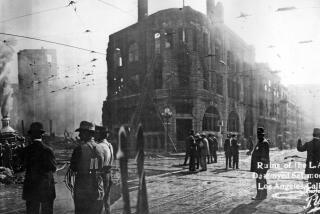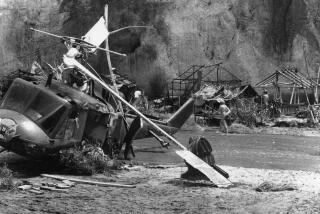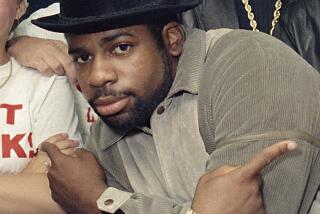Final Arguments Put Bombing Case in Jurors’ Hands
DENVER — Quoting scripture, citing law and referring to some of the world’s great writings, opposing lawyers in the Oklahoma City bombing trial argued Thursday over whether Timothy J. McVeigh was guilty of killing people he thought were part of “an evil empire” or has been wrongly accused in the nation’s worst case of mass murder.
Their voices sometimes strong, sometimes faltering as they presented their final arguments, the attorneys sought to convince a jury of seven men and five women that their side should prevail when the panel begins its deliberations here this morning. U.S. District Judge Richard P. Matsch sequestered the jury Thursday night, the first time that he has done so during the trial.
Prosecutor Larry Mackey mocked McVeigh’s self-importance as a modern patriot bent on fomenting a new American revolution. He said that the Alfred P. Murrah Federal Building employees and visitors and little children attending a day-care center there did not comprise the “evil empire” that McVeigh had come to call the federal government.
Nor, Mackey said, were any of the 168 people killed the Gestapo-like police that McVeigh was said to believe comprised much of the federal work force.
“The law enforcement officers who died were not treasonous officials, as Timothy McVeigh declared, or cowardly bastards,” Mackey said. “The credit union employees who disappeared were not tyrants whose blood had to be spilled. And certainly the 19 children who died were not the storm troopers that McVeigh said must die because of their association with the evil empire.
“In fact, they were bosses and secretaries. They were blacks, whites, mothers, daughters, fathers, sons. They were a community. So who are the real patriots and who is the traitor?”
The closing arguments wrapped up a trial that had been expected to span much of the spring and summer but instead came to an unexpectedly swift end.
In addition to those killed in the bombing, more than 500 people were injured in the April 19, 1995, blast.
Mackey was followed to the podium by chief defense attorney Stephen Jones, a small-town Oklahoma lawyer who began his final argument with a lengthy treatise on the law. Jones said that the monthlong trial was much more than just a criminal case, much more than just a legal wrangle between prosecutors and defense lawyers. This, he said, is “a moment in our history.”
Noting that the government presented a tremendous amount of heart-wrenching testimony from survivors, he called on the jury to find a similar sentiment for his client.
“Justice is blind,” he said. “Justice does not wear a mourning armband. Justice does not have a tear on its face.”
Jones made an indirect reference to the controversial not-guilty verdict in the O.J. Simpson murder case in Los Angeles as he implored the McVeigh jury not to be swayed by sympathy for the bombing’s victims.
“If we let sympathy overcome reason, then sympathy becomes to this case what race was to another case,” Jones said.
He charged that the 29-year-old McVeigh was “convicted in the court of public opinion” within minutes of being identified as the chief suspect in the case.
In urging a not-guilty verdict for McVeigh, he noted there was no direct evidence that his client had mixed the bomb or driven the truck to the front of the Murrah building. “There is no dispute that the Murrah building blew up, and there is no dispute that these victims died,” Jones said. “But it does not establish who committed the crime.”
The government put 137 witnesses on the stand to draw a detailed timeline of McVeigh’s movements over the six months leading up to the blast. The prosecutors said that he and co-defendant Terry L. Nichols, who will be tried later, spent $4,457.80 to acquire ammonium nitrate and nitromethane fuel oil and to lease storage sheds, pay for a telephone debit card and rent a 20-foot yellow Ryder truck.
The defense called just 25 witnesses in less than four days. They focused on contamination problems at the FBI crime laboratory that they said could have been the reason explosive residue was found on McVeigh’s clothing when he was arrested.
They also raised questions about a second man, known as John Doe No. 2, who some witnesses said was seen renting the truck with McVeigh, and about a mysterious leg found in the Murrah building rubble that, they said, could have belonged to the true bomber.
The closing arguments from both sides were elegant, detailed and rich in passion.
Mackey described the blast at 9:02 on a Wednesday morning. “America stood in shock,” he said. “Who could do such a thing? Who could do such a thing?
“It’s a question that began to ripple across this country, coast to coast. And finally it came to rest here in this courtroom. The answer is Timothy McVeigh.”
He said that McVeigh was moved by his anger over the FBI’s deadly 1993 raid on the Branch Davidian religious compound near Waco, Texas, in which more than 80 people died. Using underground reading materials, McVeigh began to educate himself on how to heat bomb components and build an explosive device, the lawyer said.
Mackey said that McVeigh enlisted Nichols to help him in the bombing and that the former Army friends acquired “all of the necessary components to build a massive bomb.”
He said that McVeigh specifically chose April 19 for the bombing because it was the anniversary of the Waco tragedy. And he said that McVeigh rented the truck, built the bomb and detonated it.
Mackey made this assertion even though the government’s evidence on these three steps was either lacking in some detail or missing altogether. Nevertheless, Mackey said, “that’s the government’s case. Promises made. Promises kept.”
He said that--while hundreds of police, fire and rescue workers were rushing to downtown Oklahoma City--McVeigh was driving nonchalantly in the other direction, north of town, until he was pulled over for not having a license plate.
And when he was arrested, “Timothy McVeigh tried to play it cool,” Mackey said. “He was polite. He hoped he would get by. Because no one in America would have thought that an American would have bombed his own people.”
Mackey said that an envelope in McVeigh’s car contained anti-government propaganda clippings. One was a quotation from the American patriot Samuel Adams. Below it, McVeigh had written: “Maybe now there will be liberty.”
“This is just 75 minutes after the bombing,” Mackey told the jury. “Notice he is using the present tense.”
Mackey also cited numerous other clippings that McVeigh collected, including works by Thomas Jefferson, English philosopher John Locke and Russian novelist Alexander Solzhenitsyn, all of which touched on revolutionary themes.
Summing up, Mackey spoke bluntly. “Either Timothy McVeigh bombed the Murrah building and killed all these people,” he said, “or he just happens to be the unluckiest man in the world.”
Jones rose next.
He compared Michael Fortier, who testified that his friend McVeigh had told him he had targeted the Murrah building for a terrorist act, to the character Eliza Doolittle from “My Fair Lady.”
Earlier this week, the defense had played tapes from FBI wiretaps that showed Fortier using gutter language to express himself, bragging about his importance in the case and speculating about the money he could make off it. Yet Fortier was “cleaned up” in a new suit, tie and haircut when he took the witness stand.
“My Fair Lady has become My Fair Witness,” he said.
He also ridiculed Fortier for transforming himself from one who shared McVeigh’s anti-government feelings to becoming the government’s star witness, saying that it was similar to the famous biblical story of a Roman soldier’s conversion to Christianity. “Kind of like Saul on the road to Damascus,” Jones said.
And he lampooned Fortier and his wife, Lori, who also testified against McVeigh, as “Tarzan and Jane swinging from one tree to the next” in a desperate attempt to become government informants and save themselves from being indicted in the bombing.
“Put everything they said aside,” Jones said. “They’re not important. Forget them.”
Reminding the jury that the Fortiers were drug users, Jones said, “You wouldn’t want to be associated with them.”
Finally, he came back to the mystery about the extra, unaccounted-for left leg found in the bombing debris.
“Someone blew up the Murrah building,” Jones said. “But more likely than not, several people were involved. They had skill and training, and they didn’t get it out of some book that talks about mixing it in an oven.”
“I believe the bomber of the Murrah building died in the blast.”
More to Read
Sign up for Essential California
The most important California stories and recommendations in your inbox every morning.
You may occasionally receive promotional content from the Los Angeles Times.











